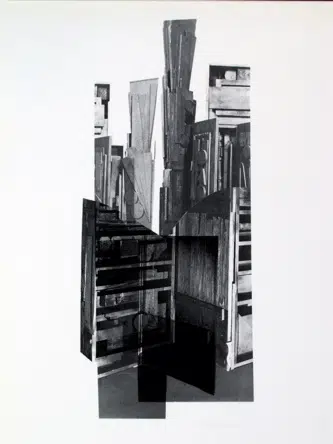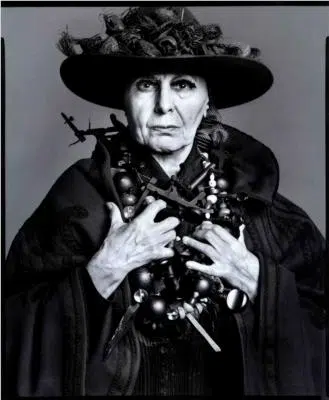The following article is written by Natasha F. Khan, Rahr-West Art Museum Collections Assistant.
“Most artists create out of despair. The very nature of creation is not a performing glory on the outside, it’s a painful, difficult search within.” – Louise Nevelson
Louise Nevelson (1899-1988) was a Ukrainian-born American sculptor. The Rahr-West Art Museum has one piece in our permanent collection by her, Composition, which was created in 1967. This piece is currently on display in the mansion in the Center Gallery. Composition is a piece from Artists and Writers Protest Against the War in Vietnam. She along with 15 other artists created a portfolio from 1966-1967 to show and encourage protest of the war. Unlike her sculptures, this piece was a screen-print. Beyond sculpting, Nevelson also drew, painted, and etched.

“Composition” by Louise Nevelson, Serigraph, 1967, 1974.012.028, Gift of Mr. & Mrs. Samuel Dorsky
The Artists and Writers Protest Against the War in Vietnam portfolio was organized by Jack Sonenberg, a New York based artist. It was created as a fundraiser for Artists and Writers Protest, Inc. Poets and artists donated their work while publishers and printers donated their time and materials. Many of the artists who participated had served in WWII and had seen the atrocities of war and wanted to promote peace. Artists and Writers Protest, Inc. was an extension of the Greenwich Village Peace Center and the War Resisters’ League that were all created by a group of poets and artists. In January of 1967, members of the groups took out a full-page ad in the New York Times urging everyone to “End Your Silence” on the war. Actors, dancers, and musicians also circulated the city on flat-bed trucks performing anti-war themed work. Other pieces from the portfolio in the museum’s collection include: Skin by Irving Petlin, Untitled by Ad Reinhart, Untitled by George Sugarman, Kill For Peace by Carol Summers, Untitled by Paul Burlin, Dipped by Allen D’Arcangelo, Untitled by Mark Di Suvero, and Red Figure by Charles Hinman.
Louise’s family immigrated to Rockland, Maine in 1905 from what is now Kyiv, Ukraine. They immigrated because of the abuse inflicted by the Tsarist Russians on the Jewish community where she was born. Louise was a leading sculptor of the 20th century but wasn’t recognized as such until she was in her 60s. Much of her early career is focused on her struggle for recognition in the male dominated field of sculpting. Her dramatic and large sculptures paved the way for the discussion in the Feminist art movement of the 1970s by breaking the taboo that only men’s artwork could be largescale. Many of her pieces are assemblage, monumental, monochromatic, wooden wall pieces and outdoor sculptures. She is also known for her “theatrical appearance”, wearing heavy mascara, mink eyelashes, wearing furs, wearing extravagant jewelry she made herself, and often wearing all black.

Louise Nevelson, photo by Richard Avedon
“Women at that time were supposed to look pretty and throw little handkerchiefs around…well, I couldn’t play that role.” – Louise Nevelson
She moved to New York in her 20s to study voice, drama, painting and drawing; attending the Art Students League in 1929-1930. After traveling to Munich, Germany she studied with Hans Hofmann, an abstract expressionist painter. After moving back to New York she worked with Diego Rivera, a muralist, who influenced her first solo show in 1941.
Louise’s subject matter came from her feelings of an uprooted childhood, clashing cultures, nature’s divinity, and feminine biography. In many of her pieces she used wooden objects that she found in urban debris piles to create narratives and call to mind the forms of city, nature, and celestial bodies, while elevating the discarded pieces of city life. Those small pieces when viewed holistically often were monumental in size, and were called “found in”. While she loved working with wooden pieces she did move on to steel, aluminum, plexiglass and other materials to create permanent pieces for the outdoors. Louise’s work focused on three colors: black, white and gold, but mostly black. “Black means totality, it means contains all…if I speak about it every day for the rest of my life, I wouldn’t finish what it really means.” – Louise Nevelson
In the 1950s as Nevelson gained recognition for her work, her style was to use open faced boxes that were stacked to make freestanding walls. Inside the boxes she displayed precisely arranged collections of abstract shaped objects mixed with chair legs, pieces of balustrades, and other found objects. Everything would be painted a single color. Once she started creating pieces for outdoors she would use the outside lighting to her advantage as well. Follow the below link for an example of one of her massive pieces:
https://www.metmuseum.org/art/collection/search/484216
Some of her most famous pieces include: Sky Cathedral 1958, Night Tree 1971, Sky Landscape 1988, Full Moon 1980, Night Sail 1985, Untitled 1970, and many more. Louise Nevelson is one of many artists, especially women artists, to prove that it’s never too late to fulfill and continue your dreams.
This video by Art Historian Deborah A Goldberg Ph. D at Rockefeller Brothers Fund, sheds further light on Louise Nevelson and her amazing and unique work.
Thinking Outside the Box: Louise Nevelson at Kykuit
Watch this fascinating video from Louise Nevelson herself from The Met.
Nevelson in Process, 1977
“I never feel age…If you have creative work, you don’t have age or time.” – Louise Nevelson

Photo © Dan Budnik
Louise Nevelson, Grand Central Gallery, New York – 1958 with CATHEDRAL I
Resources:
https://www.theartstory.org/artist/nevelson-louise/
https://louisenevelsonfoundation.org/
https://www.memphis.edu/amum/exhibitions/artistsandwriterswhoprotestthewarinvietnam.php
https://www.britannica.com/biography/Louise-Nevelson










